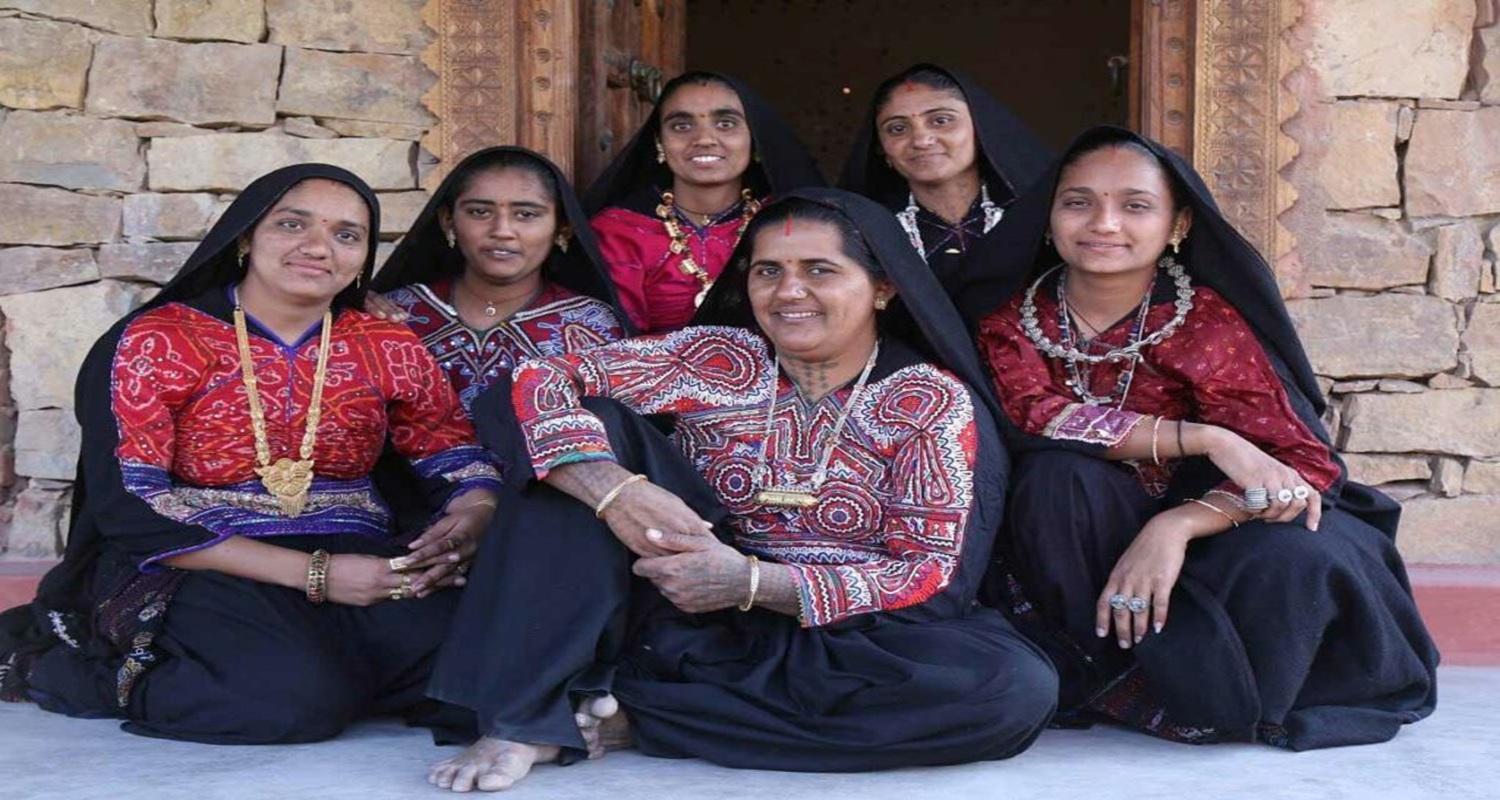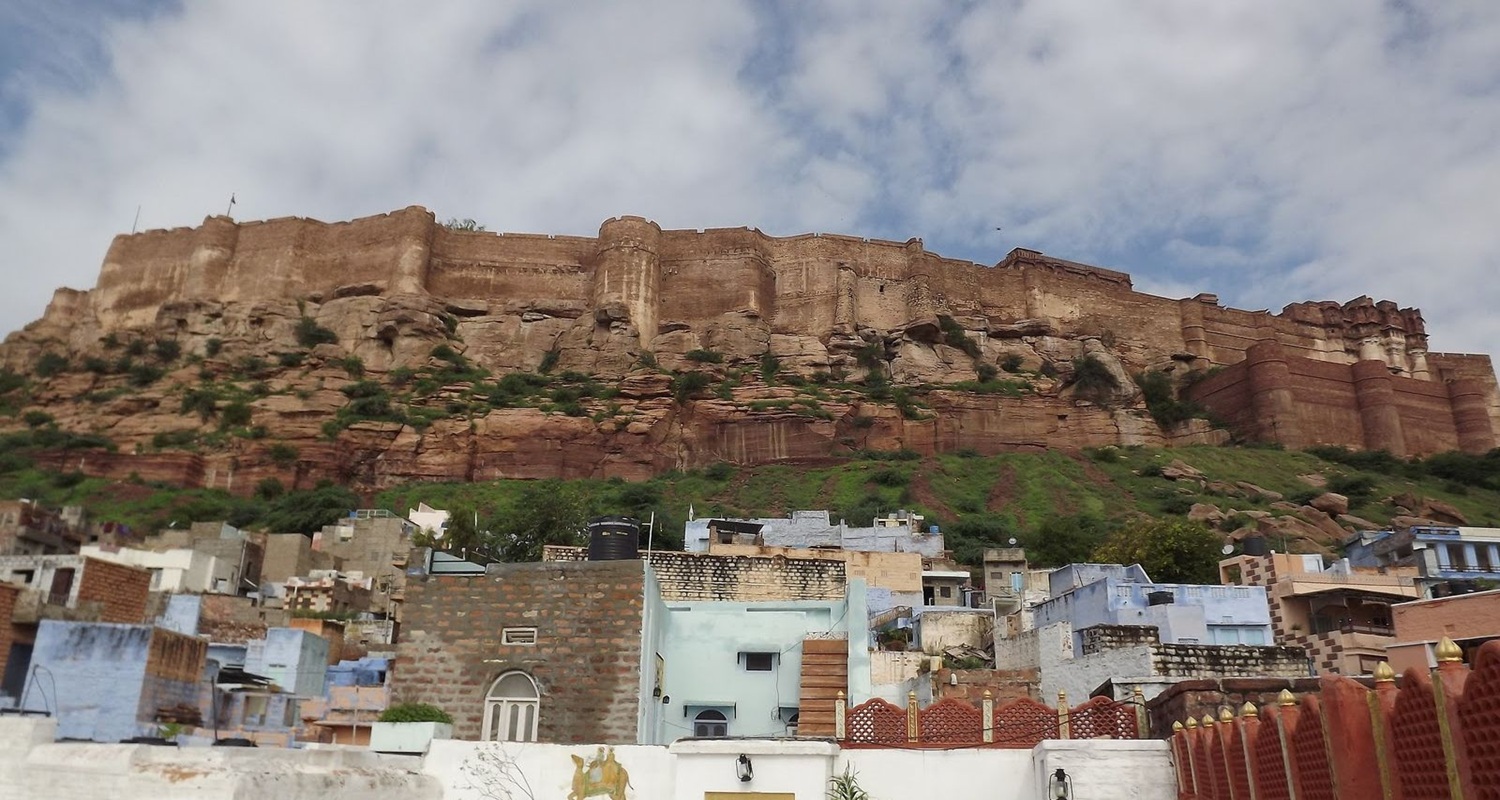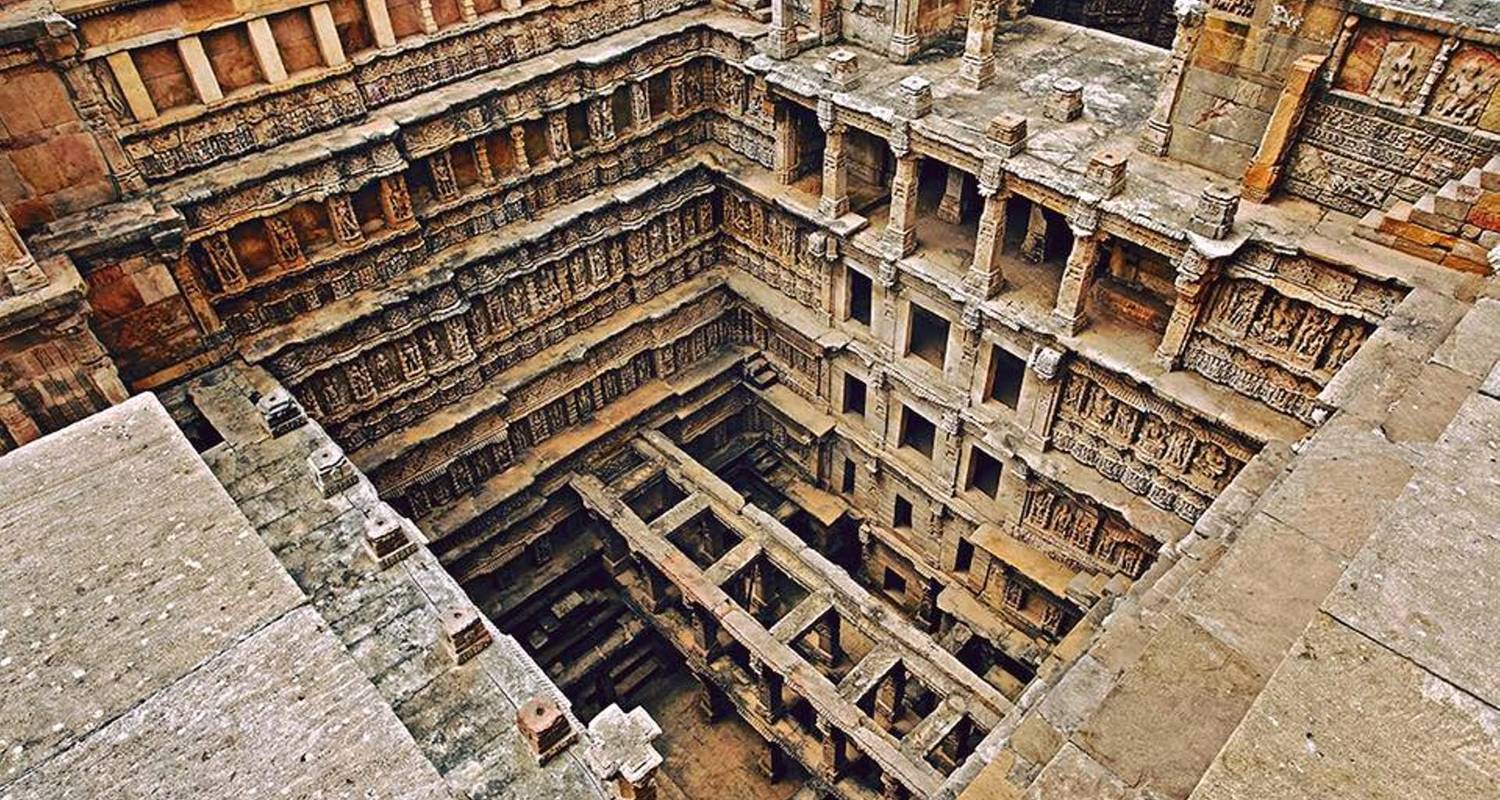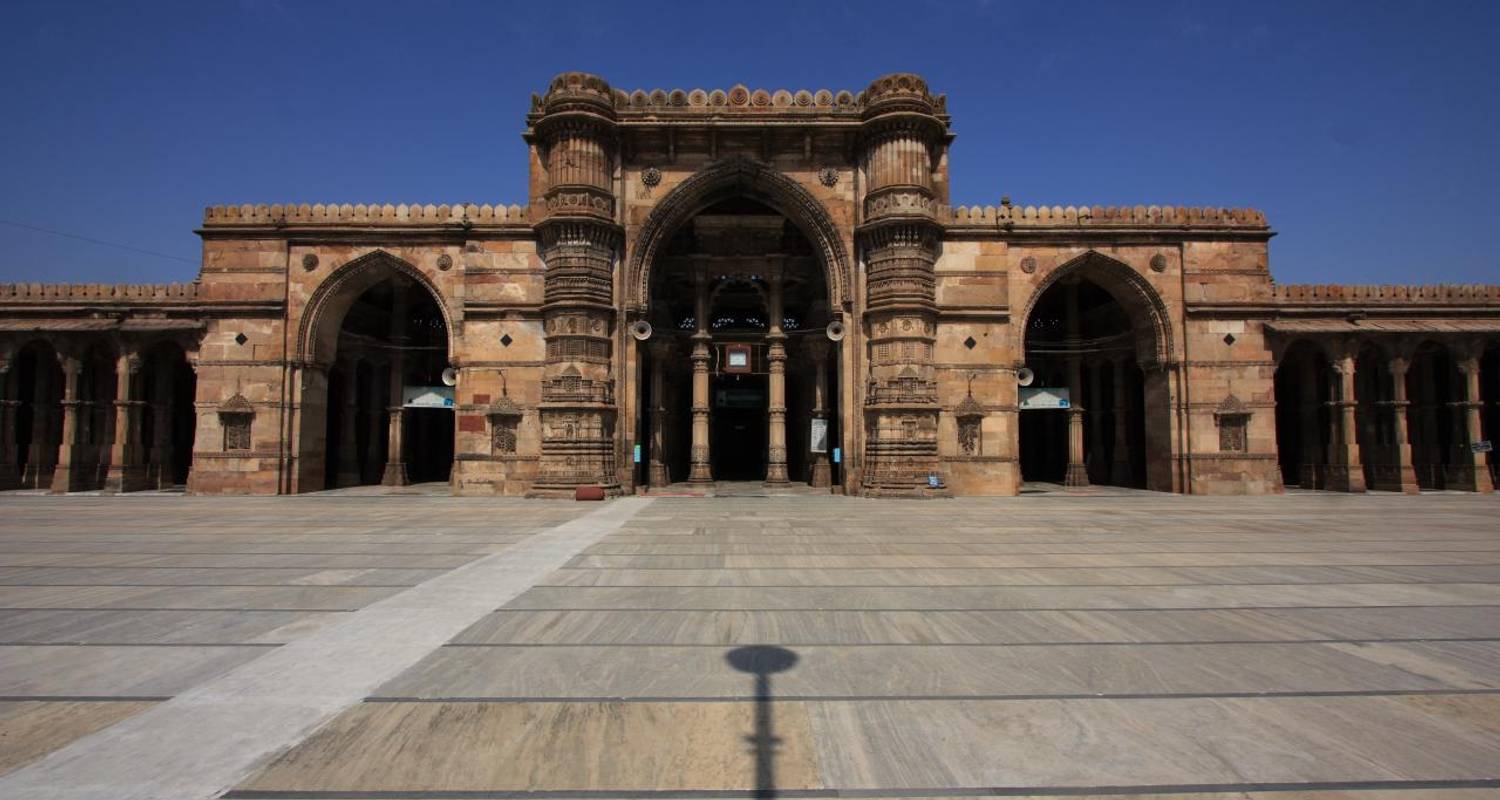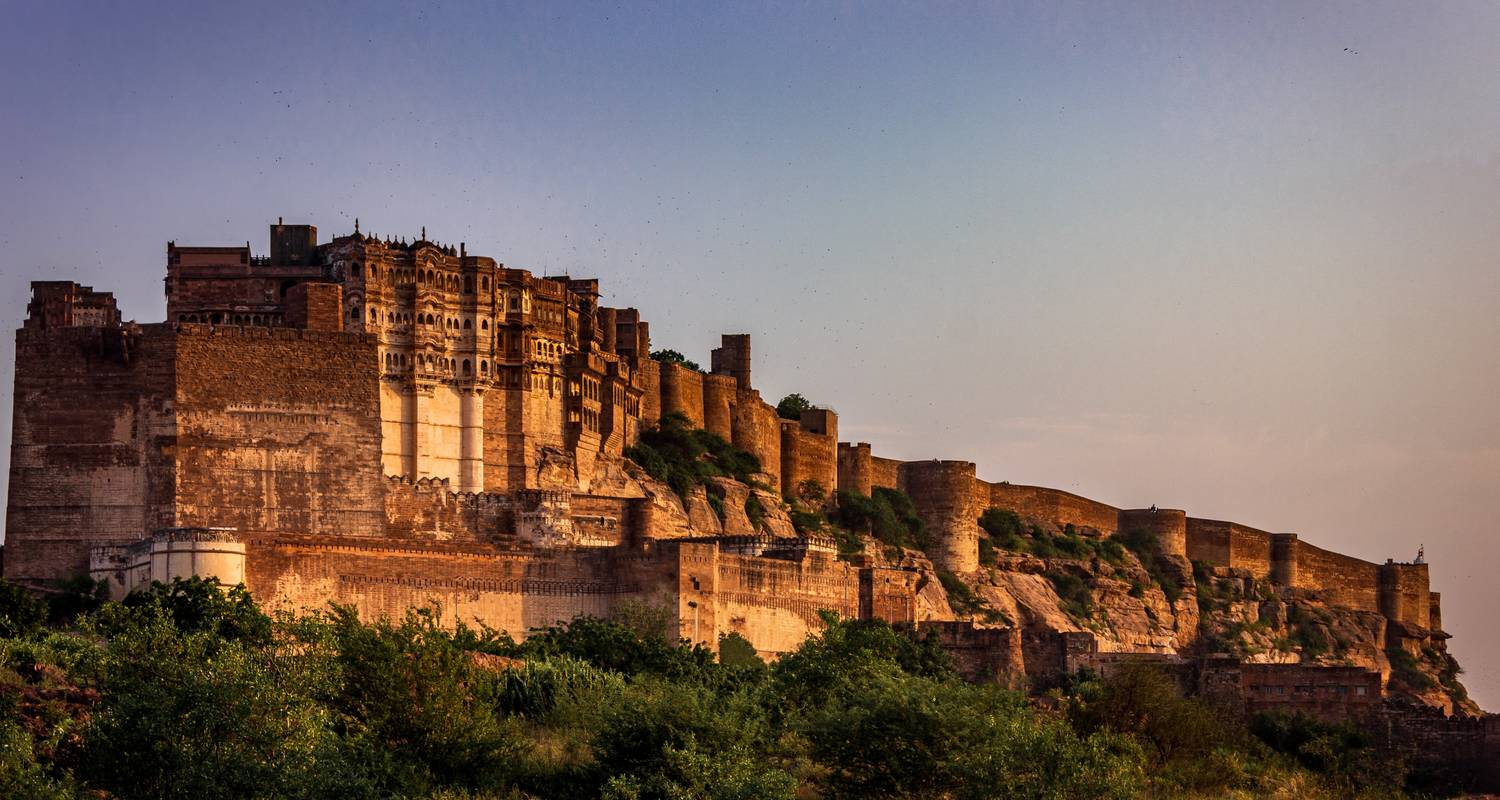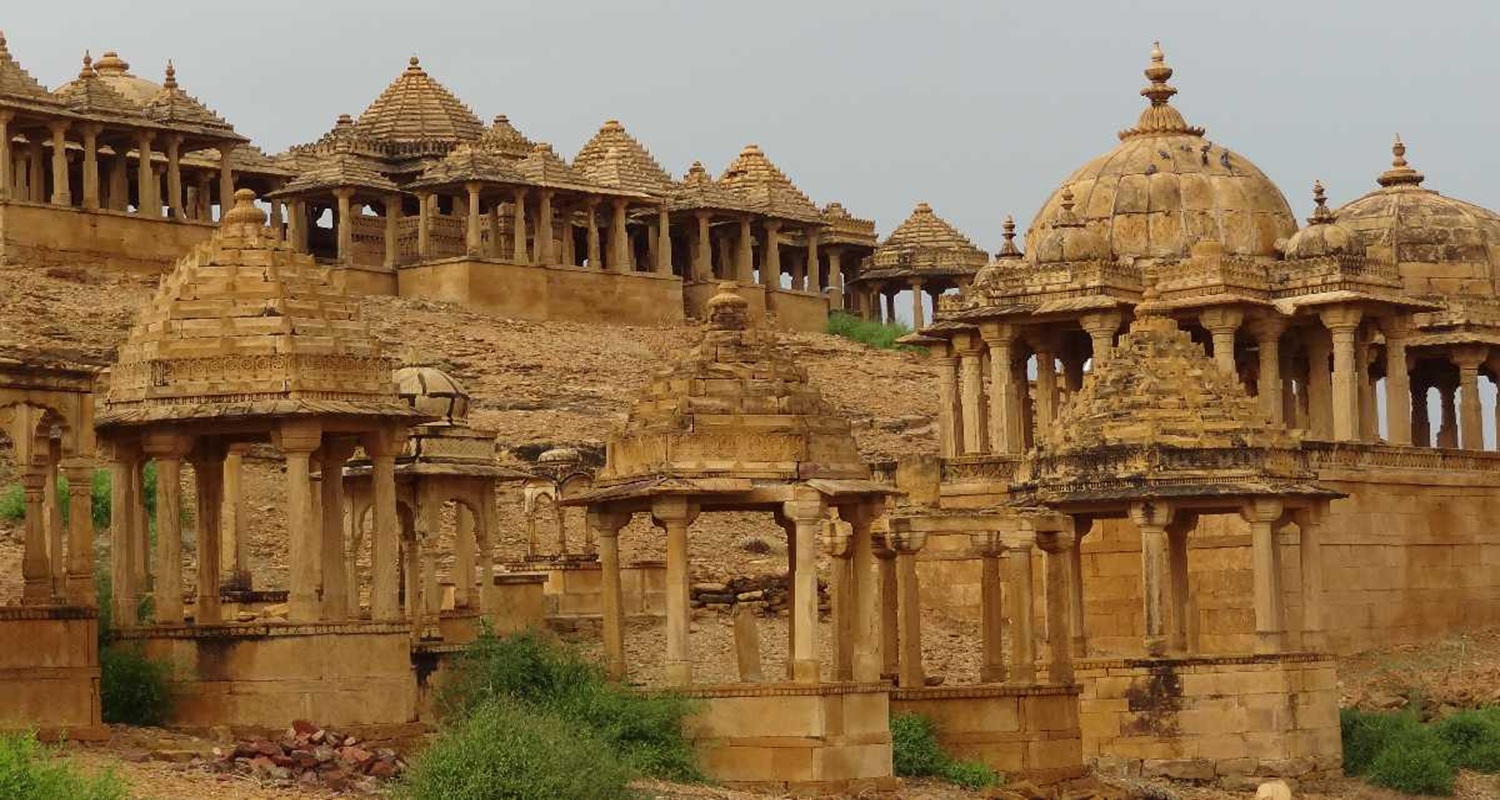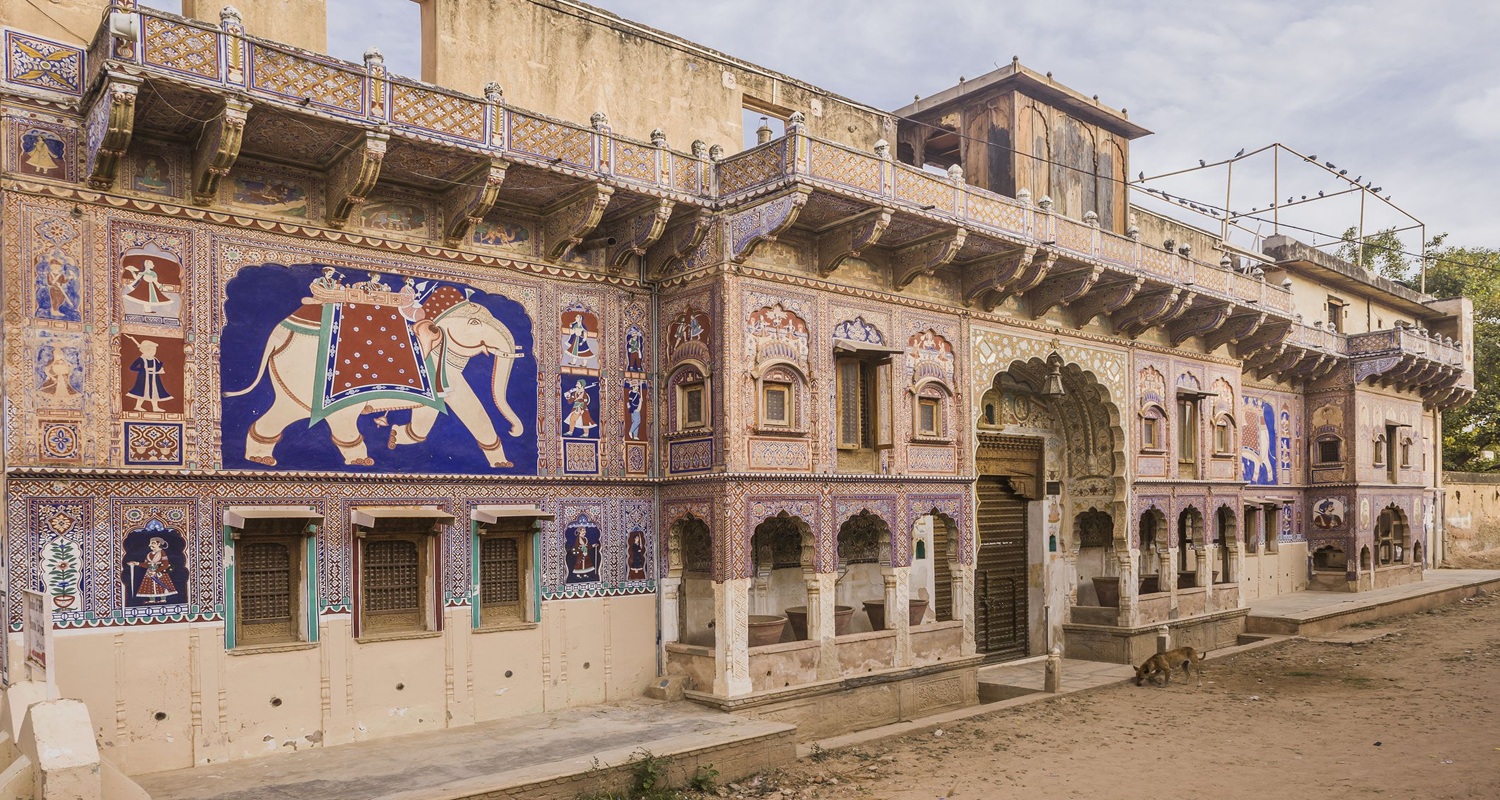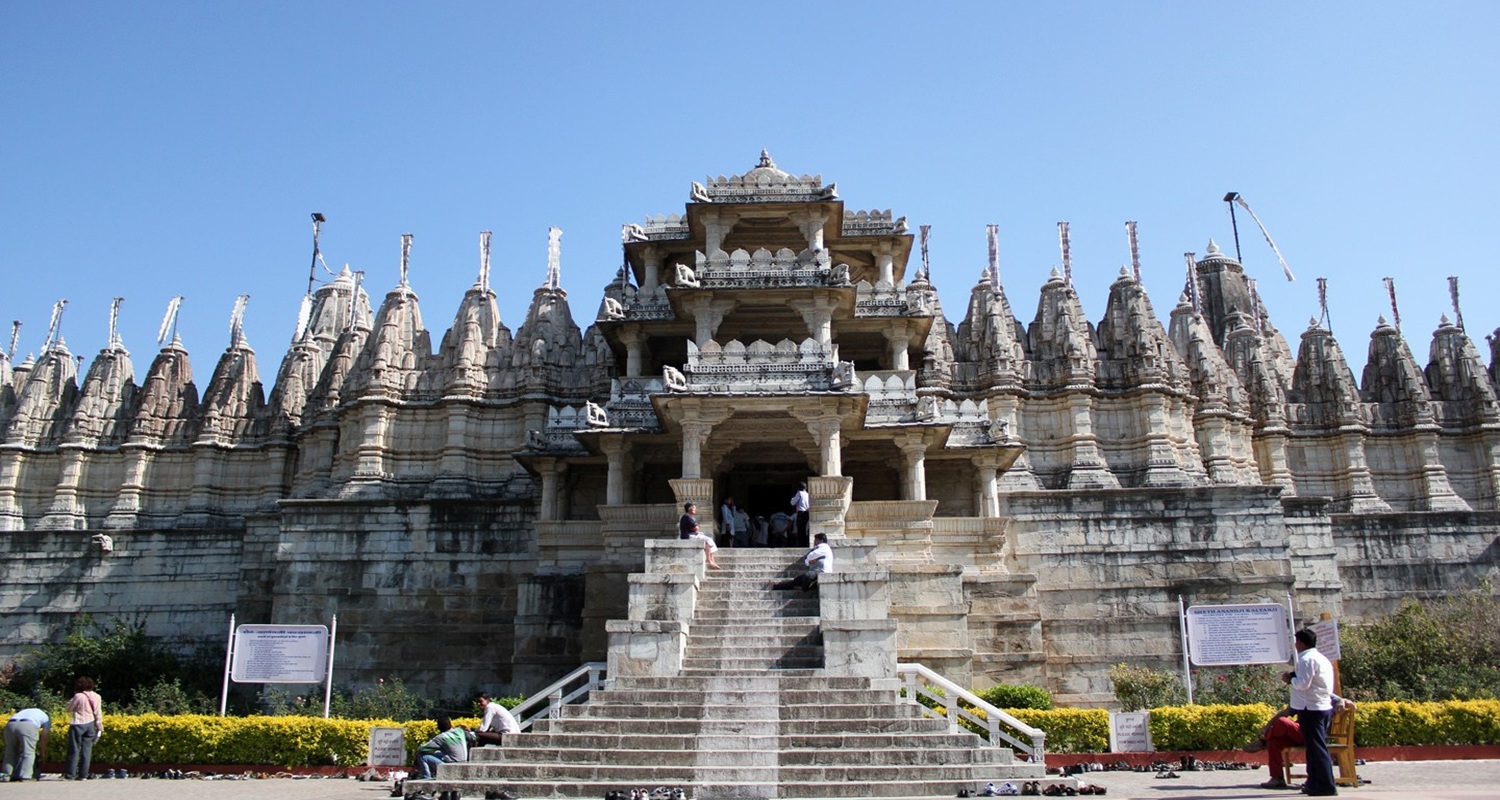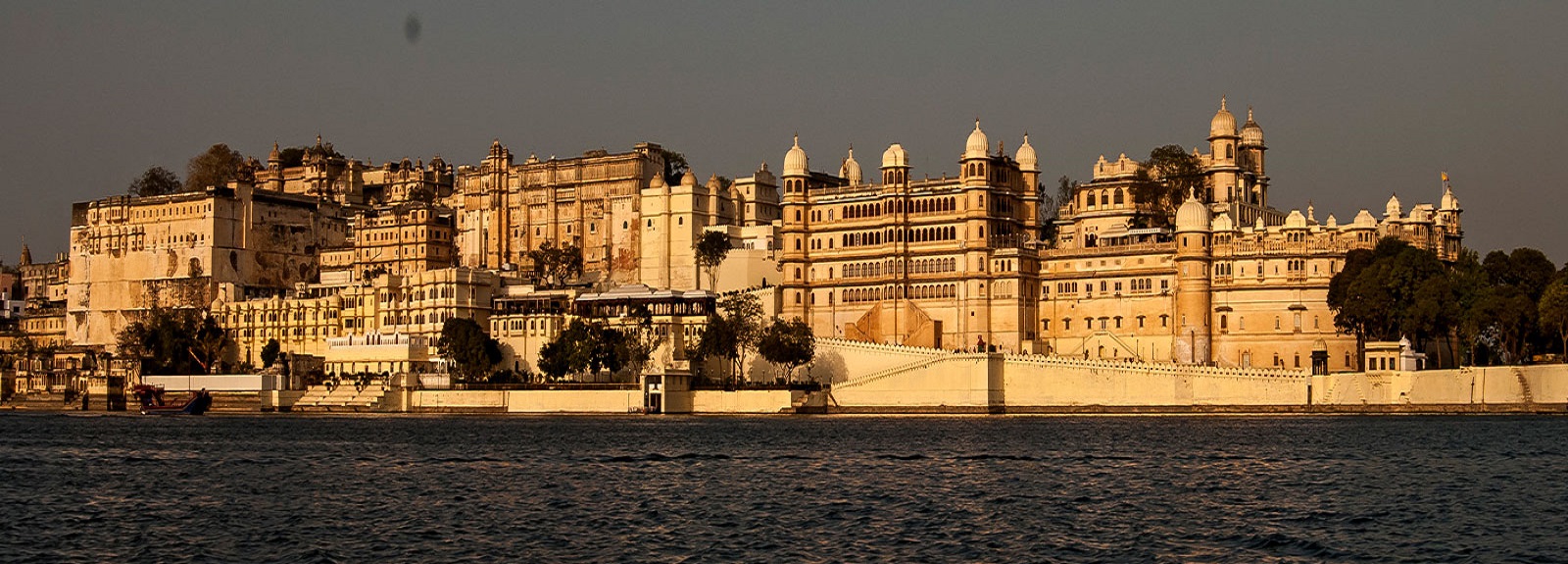
Gujrat
Splendors of Rajasthan & Gujarat
Included
INR 111500 Per Person
3-4-5 stars
Travel Duration
13 Days / 12 Nights
Included in the trip
Individual departures
Round Year
Rajasthan and Gujarat are two of the most popular tourist destinations in India, offering visitors a glimpse into the rich cultural heritage and history of the country. Both states boast of magnificent palaces, ancient temples, colorful bazaars, and stunning natural landscapes that attract travelers from all over the world. Our Tour will strat from Capital city of New Delhi and then enters in to Rajasthan through Mandawa, Bikaner and jaisalmer, cities famous for Colourful havelis and Deseres, and then you will be going to Jodhpur, famous for Meharan garh fort and Blue coloured Houses. The last city of rajasthan would be Udaipur – The city of Lakes. It is Rajasthan’s Most Romantic city, Then You enter in to Gujrat through Ahmedabad. The largest city in Gujarat, Ahmedabad is known for its beautiful mosques, including the Jama Masjid and Sidi Saiyyed Mosque. The city is also famous for its textile industry and delicious street food. The tour will continue towards dasada, Bhuj – The desert cities and Pass thorugh Gir National park – Famous for Lions. The tour shall terminante at Ahmedabad after the visit of Somnath and Palitana the most sacred sites for hindus and Muslims. This marvellous tour covers all the major attractions of both the states
Stages Of Tour
Day 1
ARRIVAL IN DELHI & SIGHT SEEING
Welcome to DELHI, The Capital of India. Your flight would land at INDIRA GANDHI INTERNATIONAL AIRPORT. After landing kindly head towards the immigration department and get your passport stamped. Immigration Department would stamp the Visa on your Passport. After the Immigration and Custom check Kindly Take an Exit from the Airport from EXIT GATE NO 4.
MY TOUR ADVISOR’S Representative would be waiting for you to welcome you outside the Gate No 4.
After the Meet Proceed towards the Visit of the CAPITAL of INDIA. You would be Covering following Monuments and activities.
1. VISIT OF OLD DELHI & JAMA MASJID
First you would be taken to the Old Part of the city, also Called as the Old City. It was once built by Emperor Shahjahan and was named Shahjahanabad. You will be visiting the JAMA MASID, the biggest Friday Mosque of India, which can host up to 20,000 Worshippers.
After the visit you can enjoy a Ride on Pedal Rickshaw through the narrow alleys of Famous Chandni Chowk Market which is famous for textiles, street food, spices, and many other items.
2. VISIT OF RAJ GHAT
After the visit of Jama Masjid Proceed Towards the Visit of RAJ GHAT which is the cremation ground of father of the Nation MAHATMA GANDHI.
3. PANORAMIC TOUR OF LUTYENS DELHI
After Paying Homage to the tomb of Mahatma Gandhi, Explore the Lutyens Delhi, Drive through India Gate, Indian Parliament and Government House.
4. VISIT OF QUTUB MINAR.
In the End Proceed towards the visit of Qutub Minar. It was built by First Muslim Ruler Qutbuddin aibak. After conquering the the last Hindu dynasty of Delhi. The Minar is a conical structure with a height of 72 metres. Once it was the most dominating structure of delhi.
After the visit you shall be transferred to your Hotels for check-in. Overnight Stay in DELHI.
Day 2
DELHI – MANDAWA (260 KM – 5:30 HOURS)
After the Breakfast, Drive towards Mandawa.
Mandawa is located in Rajasthan’s Shekhawati region, is a charming town famed for its stunning painted havelis (traditional mansions). Once a prosperous stop on ancient trade routes, Mandawa flourished under wealthy merchant families who built grand residences adorned with intricate frescoes, murals, and ornamental architecture. The Mandawa Fort, now a heritage hotel, overlooks the town’s maze of narrow streets and richly decorated buildings. Notable havelis include the Jhunjhunwala Haveli, Goenka Haveli, and Murmuia Haveli, showcasing themes from mythology, colonial life, and daily village scenes. Today, Mandawa is often called an open-air art gallery, attracting heritage lovers and photographers worldwide.
On Arrival checkin to the Hotel and In the afternoon Visit of the Town with Its Havelis. After the visits return to the Hotel for Overnights Stay.
Day 3
MANDAWA - BIKANER (190 KM - 4 Hrs Approx)
MANDAWA - BIKANER (190 KM - 4 Hrs Approx)
After the breakfast transfer to Bikaner.
Bikaner, located in the northwestern part of Rajasthan, is a vibrant desert city known for its rich heritage, majestic forts, and camel culture. Founded in 1488 by Rao Bika, it rose to prominence as a powerful princely state. The city is home to the magnificent Junagarh Fort, famous for its intricate carvings and impressive architecture, and the grand Laxmi Niwas Palace. Bikaner is also renowned for its Camel Festival.
On Arrival check-in to the Hotel. In the After Visit the Junagarh Fort and the Old Town.
1. JUNAGARH FORT
Junagarh Fort, located in Bikaner, Rajasthan, is one of the few major forts in India not built on a hilltop. Constructed in 1589–1594 by Raja Rai Singh, a general in the Mughal army, the fort is renowned for its blend of Rajput, Mughal, and Gujarati architectural styles. Unlike many forts, Junagarh has never been conquered, adding to its historic prestige. Inside the fort complex are palaces, courtyards, balconies, temples, and pavilions, each richly decorated with marble, mirror work, frescoes, and intricate carvings. Notable structures include Anup Mahal, Badal Mahal, and Phool Mahal. The fort also houses a museum showcasing royal artifacts, costumes, and weapons. Surrounded by a high stone wall with bastions, Junagarh Fort stands as a majestic symbol of Bikaner’s royal legacy and architectural brilliance.
Later explore the old town with its markets and Havelis which still hold the old time charm. Later return to the Hotel for overnight Stay.
Day 4
BIKANER - JAISALMER (330 KM - 6 Hrs Approx)
BIKANER – JAISALMER (330 KM - 6 Hrs Approx)
Breakfast at the hotel and proceed to Jaisalmer, crossing almost all of the Thar desert, on the border with Pakistan. Jaisalmer is probably the most attractive destination of the entire trip. Arrival and Checkin the Hotel. Afternoon visit the Vyas ki Chattari, the cenotaphs of the royal family. Overnight stay in Jaisalmer.
1. VYAS CHATTRI
Vyas Ki Chhatri, located on the edge of Jaisalmer city in Rajasthan, is a group of beautifully carved cenotaphs (chhatris) dedicated to Sage Vyas, the legendary author of the Mahabharata. These golden sandstone structures are built on a small hill and offer a peaceful setting with stunning views of Jaisalmer Fort, especially during sunset. Though it is a cremation ground, the site is visited for its architectural beauty, quiet ambiance, and cultural significance. The chhatris feature intricately carved pillars, domes, and canopies, showcasing classic Rajput craftsmanship. It’s a lesser-known yet atmospheric spot for history lovers and photographers alike.
Day 5
JAISALMER SIGHTSEEING
Jaisalmer, often called the "Golden City", is a mesmerizing desert town in Rajasthan, known for its golden-hued sandstone architecture and majestic Thar Desert landscapes. Founded in 1156 AD by Rawal Jaisal, the city is crowned by the magnificent Jaisalmer Fort, a living fort that still houses shops, homes, and temples. The fort and the intricately carved Havelis like Patwon Ki Haveli and Salim Singh Ki Haveli reflect the city's rich artistic and architectural legacy. Jaisalmer is also famous for its sand dunes, camel safaris, and vibrant folk music and dance that bring the desert to life. Attractions like Gadisar Lake, Vyas Chhatri, and Jain Temples add spiritual and historical charm. The city’s golden glow at sunset, coupled with its royal heritage and warm hospitality, makes Jaisalmer a must-visit destination for those seeking a blend of history, culture, and desert adventure.
Full Day Dedicated to the visit of Fort, Havleis and Temples.
1. JAISALMER FORT COMPLEX
Visit the Jaisalmer Fort Complex, also known as Sonar Quila or the Golden Fort, is one of the largest and most magnificent forts in the world. Built in 1156 AD by Rawal Jaisal, it rises like a golden mirage from the Thar Desert, constructed entirely of yellow sandstone that glows brilliantly in the sunlight. Unlike most forts, Jaisalmer Fort is a living fort—home to thousands of people, with houses, temples, shops, and hotels inside its massive walls. The fort features narrow winding lanes, beautifully carved Jain temples, and grand Raj Mahal (Royal Palace). It stands on Trikuta Hill, with 99 bastions that provide stunning views of the desert city below. Rich in Rajput history, art, and architecture, the fort has withstood many battles and still stands as a symbol of Rajasthan's enduring legacy.
2. JAIN TEMPLES
Afterwards visit the Jain Temples. Made from golden-yellow sandstone, the temples are renowned for their exquisite carvings, detailed sculptures, and intricate architecture, often compared to the Dilwara Temples of Mount Abu. The interiors are adorned with images of deities, celestial dancers, animals, and mythological scenes, all finely chiseled in sandstone.
3. HAVELIS
The Havelis of Jaisalmer are grand mansions built by wealthy merchants during the 18th and 19th centuries, showcasing the city’s rich artistic and architectural legacy. Made from golden Jaisalmer sandstone, these havelis are adorned with intricately carved facades, jharokhas (balconies), latticed windows, and detailed frescoes that reflect a blend of Rajput and Mughal styles.
Afternoon Excursion to the Sam Sand dunes for a ride on Camel and to view the sand dunes at setting sun. Return to the Hotel, Overnight stay in Jaisalmer.
Day 6
JAISALMER - JODHPUR (285 KM - 5 Hrs Approx)
JODHPUR, known as the "Blue City", is a historic city in Rajasthan, famous for its striking blue-painted houses and majestic Mehrangarh Fort that towers over the city. Founded in 1459 by Rao Jodha, it was the capital of the Marwar kingdom. Jodhpur offers a blend of royal heritage, vibrant bazaars, and desert charm. Key attractions include Umaid Bhawan Palace, Jaswant Thada, and bustling markets near the Clock Tower. The city is also known for its traditional Rajasthani cuisine, handicrafts, and festivals. Surrounded by the Thar Desert, Jodhpur captures the essence of Rajasthan’s regal past and colorful culture.
After breakfast, transfer to the Jodhpur, On Arrival visit of the Mehrangarh Fort and Jaswant thada.
1. MEHRANGARH FORT
Perched on a rocky hill 400 feet above Jodhpur, It is one of the largest and most majestic forts in India. Built in 1459 by Rao Jodha, the founder of Jodhpur, the fort is enclosed by thick stone walls and offers panoramic views of the Blue City below. Its imposing gates, like Jayapol and Fatehpol, lead to a complex of richly decorated palaces, courtyards, galleries, and temples. Inside, the Mehrangarh Museum showcases royal artifacts, weapons, costumes, and miniature paintings. Highlights include the Phool Mahal, Sheesh Mahal, and Moti Mahal, each reflecting exquisite Rajput architecture. Mehrangarh Fort stands as a symbol of Rajasthan’s royal heritage, valor, and architectural brilliance.
2. JASWANT THADA
After the visit proceed to JASWANT THADA.
Jaswant Thada is a beautiful white marble cenotaph located near Mehrangarh Fort in Jodhpur, Rajasthan. Built in 1899 by Maharaja Sardar Singh in memory of his father, Maharaja Jaswant Singh II, it serves as a royal cremation ground for the Marwar rulers.
Often called the "Taj Mahal of Marwar", Jaswant Thada is known for its elegant Rajput architecture, intricately carved marble lattice screens (jalis), and peaceful atmosphere. The marble used is so finely polished that it glows when sunlight passes through. Inside, you'll find portraits of Rathore rulers, along with beautifully maintained gardens and a small lake nearby.
After the visit take a walk in the old city with its colourful Markets and Historical Buildings. Afterwards proceed towards the Hotel for check-in and Over night Stay.
Day 7
JODHPUR - RANAKPUR - UDAIPUR (270 KM - 7 Hrs Approx)
After the breakfast transfer to Udaipur via Ranakpur. The Temple complex opens at 12 PM for the visits.
Arrive and visit the Temples.
1. RANAKPUR
Ranakpur Jain Temple, located in the serene Aravalli hills of Rajasthan, is one of the most spectacular and important Jain temples in India. Dedicated to Tirthankara Adinatha, it was built in the 15th century during the reign of Rana Kumbha and is renowned for its marble architecture, spiritual ambiance, and intricate craftsmanship. The temple complex covers around 48,000 square feet and is supported by 1,444 uniquely carved marble pillars, no two of which are alike. The temple features shikharas (spires), domes, and detailed sculptures that depict deities, dancers, and celestial beings with breathtaking precision.
Apart from the main temple, the complex includes smaller shrines dedicated to other Jain Tirthankaras and deities. Set amid forested hills, Ranakpur offers a peaceful, meditative experience, drawing not just devotees but also lovers of art, history, and architecture from around the world.
After the visit proceed towards UDAIPUR. On Arrival in Udaipur check-in to the Hotel, Overnight Stay in Udaipur.
Day 8
UDAIPUR SIGHTSEEING
UDAIPUR - known as the "City of Lakes", is a stunning city in Rajasthan, famous for its serene lakes, royal palaces, and romantic ambiance. Founded in 1559 by Maharana Udai Singh II, it served as the historic capital of the Mewar Kingdom. The city’s crown jewel is the City Palace, overlooking the shimmering Lake Pichola, home to the iconic Lake Palace and Jag Mandir. Udaipur’s charm lies in its heritage architecture, vibrant markets, colorful festivals, and cultural performances. Surrounded by the Aravalli Hills, Udaipur offers a perfect blend of natural beauty, history, and royal elegance, making it a beloved destination.
Full day dedicated to the visit and exploration of the most important monuments of the city Starting from.
1. CITY PALACE UDAIPUR
The City Palace of Udaipur is one of the largest and most majestic palace complexes in Rajasthan, located on the eastern banks of Lake Pichola. Built by Maharana Udai Singh II in 1559, and expanded over 400 years by successive rulers, the palace showcases a blend of Rajput, Mughal, European, and Chinese architectural styles. Constructed with granite and marble, the City Palace is a stunning complex of palaces, courtyards, pavilions, terraces, hanging gardens, and balconies. Inside, visitors can explore the City Palace Museum, which houses royal artifacts, vintage weapons, costumes, and paintings. Highlights include Mor Chowk (Peacock Courtyard), Sheesh Mahal (Mirror Palace), Zenana Mahal, and Krishna Vilas.
From its balconies and towers, the palace offers panoramic views of Lake Pichola, the Lake Palace, and the Aravalli Hills. It's not just a historic site, but a living legacy of Mewar's royal heritage.
2. JAGDISH TEMPLE
Afterwards proceed towards the visit of Jagdish Temple, It is one of the most prominent and historic temples in Udaipur, located just outside the City Palace complex. Built in 1651 by Maharana Jagat Singh I, it is dedicated to Lord Vishnu, worshipped here as Jagannath (Lord of the Universe).
Constructed in the Indo-Aryan architectural style, the temple stands on a tall plinth and can be reached via a steep flight of steps. The main shrine houses a stunning four-armed black stone idol of Vishnu, carved from a single piece of stone. The temple is richly decorated with intricate carvings, elaborate pillars, beautiful ceilings, and sculptures of gods, elephants, dancers, and musicians.
3. SAHELIYO KI BARI
Later visit Saheliyon Ki Bari, or the Garden of the Maidens, is one of Udaipur’s most enchanting and tranquil attractions. Built in the early 18th century by Maharana Sangram Singh II, it was designed as a recreational garden for the royal ladies and their companions (sahelis). According to legend, the garden was a wedding gift for the queen and her 48 maids who came with her from the royal household of Marwar.
4. LAKE PICHOLA BOAT RIDE
End your day with a mesmerizing Boat Ride at Lake Pichola. Boat ride at Pichola is one of the most serene and magical experiences the city offers. Surrounded by the Aravalli Hills and dotted with architectural marvels, the calm waters reflect the golden hues of the palaces and the sky, especially at sunrise or sunset, making it an unforgettable experience.
As the boat glides over the lake, you’ll pass iconic landmarks like the Taj Lake Palace, which appears to float on the water, the Jag Mandir Island Palace, and the ghats and heritage buildings of Old Udaipur. The ride often includes a stop at Jag Mandir, where you can explore its gardens and enjoy lake views.
Later return to the city for overnight Stay.
Day 9
UDAIPUR - AHMEDABAD (260 KM - 6 Hrs Approx)
After Breakfast depart for Ahmedabad, The Capital city of Gujrat. On Arrival check in to the Hotel. In the afternoon visit of the city, You would be Covering following Monuments and activities.
AHMEDABAD
Ahmedabad, the largest city in the Indian state of Gujarat, is a vibrant blend of history, culture, and modern development. Founded in 1411 by Sultan Ahmed Shah on the banks of the Sabarmati River, the city has evolved from a medieval walled city to a thriving urban center. It holds immense historical importance, especially as the home of Mahatma Gandhi’s Sabarmati Ashram, which became a pivotal site during India’s freedom struggle. Ahmedabad was declared India’s first UNESCO World Heritage City in 2017, a recognition of its beautifully preserved old city architecture, intricate wooden houses in narrow lanes known as pols, and historic landmarks like the Jama Masjid and Sidi Saiyyed Mosque.
1. VISIT OF OLD CITY AND JAMA MASJID
The Jama Masjid in Ahmedabad is one of the most magnificent and his3torically significant mosques in India. Built in 1424 AD by Sultan Ahmed Shah, the founder of Ahmedabad, it stands in the heart of the old city near the Bhadra Fort. The mosque was originally intended for the private use of the royal family and nobles of the sultanate.
Architecturally, the Jama Masjid is a stunning blend of Indo-Islamic and Hindu styles, reflecting the craftsmanship of local artisans. The mosque is built primarily from yellow sandstone and features a vast courtyard, 15 domes, and more than 260 intricately carved columns. The prayer hall, with its beautifully detailed pillars and lattice screens (jalis), is especially impressive. The use of light and space inside the mosque creates a peaceful and spiritual atmosphere.
One of the unique features of the Jama Masjid is its incorporation of Hindu and Jain motifs, such as lotus patterns and bell-like designs, which is a result of local influence and the reuse of materials from earlier temples. This artistic fusion makes the mosque not only a place of worship but also a symbol of cultural harmony and architectural brilliance.
Adjacent to the mosque is the tomb of Sultan Ahmed Shah, along with those of his son and grandson, making the area an important heritage site. Take a stroll in the old city experiencing its colours.
2. SABARMATI ASHRAM
Sabarmati Ashram, also known as the Gandhi Ashram, is one of the most iconic and historically significant landmarks in Ahmedabad. Located on the peaceful banks of the Sabarmati River, it was established by Mahatma Gandhi in 1917 after his return from South Africa. The ashram became the center of India’s freedom movement, where Gandhi lived with his wife Kasturba and many followers, and from where he planned major campaigns of civil disobedience.
One of the most famous events associated with Sabarmati Ashram is the Dandi March or Salt Satyagraha, which began from here on 12th March 1930. Gandhi, along with 78 followers, marched over 240 km to the coastal village of Dandi to protest the British salt tax. This act of nonviolent resistance became a turning point in India’s struggle for independence.
The ashram is now a national monument and museum, preserving the simple lifestyle and powerful legacy of Mahatma Gandhi. Visitors can explore Hriday Kunj, the cottage where Gandhi lived, which still contains his personal belongings like his spinning wheel (charkha), writing desk, and letters. The museum houses photographs, letters, and exhibits that narrate Gandhi’s life, philosophy of nonviolence (ahimsa), and the independence movement.
Sabarmati Ashram is not only a place of historical importance but also a symbol of peace, simplicity, and determination. Surrounded by greenery and open spaces, it continues to inspire people from around the world who come to learn about Gandhian values and India’s freedom struggle.
After the visit return to the Hotel for check in and overnight Stay.
Day 10
AHMEDABAD - PATAN - MODHERA– DASADA (200 Km | 4 Hrs Approx)
After breakfast drive to Dasada. On the way, stop at the ancient capital Patan and visit the marvellous step well “Rani Ki Vao”. Later stop at Modhera to visit the Sun God Temple, which represents one of the greatest masterpieces of the Hindu architecture of the Solanki period.
1. RANI KI VAO
Rani ki Vav (Queen’s Stepwell) is a spectacular stepwell located in Patan, a historic town in the northern part of Gujarat, India. It is one of the finest and most ornate stepwells in the country and was declared a UNESCO World Heritage Site in 2014 due to its exceptional architectural and cultural significance.
Rani ki Vav was built in the 11th century by Queen Udayamati, the wife of King Bhima I of the Solanki dynasty, in memory of her husband. Unlike ordinary stepwells that were primarily used for water storage, Rani ki Vav was designed as a temple-like structure and a memorial, combining both utility and beauty. It served not just as a water reservoir but also as a place for rest and reflection.
The stepwell is famous for its intricate carvings and sculptures that cover nearly every surface. The structure is built in the Maru-Gurjara architectural style, with a depth of about 27 meters and a length of 64 meters. It consists of seven levels of stairs leading down to the water, with more than 1,500 finely sculpted figures. The sculptures mostly depict Hindu deities, especially Vishnu in various forms like Kalki, Rama, Krishna, and Vamana. There are also images of apsaras (celestial dancers), sages, and scenes from mythology.
One of the most remarkable features of Rani ki Vav is how it was constructed inverted like a temple, with its sanctity increasing as one descends deeper toward the water. The stepwell was buried under silt for centuries after the Saraswati River changed its course but was rediscovered and restored by the Archaeological Survey of India.
2. MODHERA
The Sun Temple in Modhera, located in Modhera village of Mehsana district, Gujarat, is one of the most magnificent and ancient temples in India dedicated to the Sun God (Surya). Built in the early 11th century during the reign of King Bhima I of the Solanki dynasty, the temple is a masterpiece of Solanki architecture, which closely resembles the Maru-Gurjara style. The Solankis considered themselves descendants of the Sun God, and this temple reflects their devotion and architectural brilliance.
The temple complex is divided into three main parts:
1. Surya Kund (Ramakund) – A large rectangular stepped tank in front of the temple, surrounded by small shrines dedicated to various deities. Devotees used to bathe here before entering the temple for worship.
2. Sabha Mandap (Assembly Hall) – A beautifully carved pillared hall used for religious gatherings and rituals. The hall features intricate carvings on its walls, pillars, and ceiling, depicting scenes from Hindu mythology.
3. Guda Mandap (Sanctum Sanctorum) – The innermost part where the idol of the Sun God would have been enshrined (now missing). The structure is designed in such a way that during the equinoxes, the first rays of the rising sun would directly illuminate the sanctum.
The entire temple is adorned with exquisite stone carvings of gods, goddesses, celestial beings, dancers, and floral patterns. No worship is performed here today, as it is no longer an active temple, but it stands as a protected monument under the Archaeological Survey of India.
After the visit proceed towards Dasada, On Arrival at Dasada check-in to the Hotel, Overnight Stay in Dasada.
Day 11
DASADA - BHUJ (290 Km | 6 hrs approx.)
Early Morning safari in Dasada Wild Ass wildlife Sanctury.
The sanctuary is home to the Indian Wild Ass, a strong and fast-moving animal known for its striking reddish-brown color and white markings. These wild asses are unique to India and have adapted well to the extreme conditions of the Rann. Apart from the wild ass, the sanctuary also hosts Desert foxes, Indian wolves, Striped hyenas, Nilgai (blue bull), Jackals, Chinkaras (Indian gazelles).
After the visit Proceed towards BHUJ. On Arrival check-in to the Hotel for overnight Stay.
BHUJ
Bhuj, a historic city in Gujarat’s Kutch district, is known for its rich heritage, vibrant culture, and traditional arts. Once the capital of the princely state of Kutch, it is home to stunning architectural landmarks like Aina Mahal, Prag Mahal, and Bhujia Fort, reflecting its royal past. Bhuj is also famous for its skilled artisans and diverse handicrafts, including Bandhani (tie-dye), Ajrakh block printing, Rogan art, and intricate embroidery created by various local communities. The city serves as the main gateway to the Great Rann of Kutch, a vast white salt desert, and hosts the famous Rann Utsav, a vibrant festivalshowcasing music, dance, crafts, and local cuisine. It is a perfect destination for those interested in history, traditional crafts, and Gujarat’s unique desert landscapes.
Day 12
EXCURSION TO GREAT RANN OF KUTCH & VISITS OF TRIBAL VILLAGES.
After Breakfast. Full day excursions to visit the great Great Rann of Kutch, one of the largest salty white deserts in the world known for its biodiversity. Along the way you can visit Villages of Rabari, Harijan tribes, Maldharis and Lohars TRIBES who have managed to protect their ancient culture and idinetity.
1. RANN OF KUTCH
The Great Rann of Kutch is one of the most extraordinary natural landscapes in India, located in the Kutch district of Gujarat, near the border with Pakistan. It is a vast white salt desert covering approximately 7,500 square kilometers, making it one of the largest salt flats in the world. The word *"Rann"* comes from the Sanskrit word Irina, meaning desert. This incredible terrain is submerged under water during the monsoon season and turns into a dry, shimmering expanse of white salt in the winter. The full moon nights are especially breathtaking, as the salt plains reflect moonlight, creating a surreal landscape.
The Great Rann is also home to wildlife sanctuaries, including nesting grounds for flamingos and migratory birds, and has deep cultural significance for local communities like the Rabari, Mutwa, and Ahir. Its unique ecosystem, stunning views, and vibrant culture make it a must-visit destination for nature lovers, photographers, and cultural explorers.
2. VISIT OF TRIBAL VILLAGES
The Rabari, Mutwa, and Ahir are traditional communities of Kutch, Gujarat, each with a distinct cultural identity, livelihood, and rich artistic heritage. These tribes have lived in harmony with the harsh desert environment of the Rann of Kutch for centuries and are known for their unique clothing, craftsmanship, and traditions.
The Rabaris are semi-nomadic pastoralists, traditionally herding camels, sheep, and goats. They are known for their distinctive dress—men often wear white dhotis and turbans, while women wear black woolen garments with heavy silver jewelry and elaborate embroidery. Rabari women are especially skilled in hand embroidery, creating intricate patterns that reflect their myths, beliefs, and daily lives.
The Mutwas are a Muslim community known for their exquisite fine embroidery work, particularly Soof and Kharek embroidery.
The Ahirs are traditionally agriculturalists and cattle herders, with roots believed to trace back to the Yadava clan associated with Lord Krishna
After the Visit return to the Hotel for check-in & Overnight Stay.
Day 13
BHUJ – DELHI (Flight – 2 Hours)
BHUJ – DELHI (Flight – 2 Hours)
Morning at Leisure. After checkout transfer to Airport to catch the flight for Delhi. On Arrival transfer to International Terminal to catch the flight for your onward Destination.
The hotels
My Tour Advisor Provides a wide variety of hotels
Cost Per Person For Different Categories
| # | No of Pax | Standard | Superior | Prestige |
|---|---|---|---|---|
| 1 | 2 Pax | INR 11500 | INR 135000 | INR 165000 |
| 2 | 4 Pax | INR 100000 | INR 121800 | INR 148000 |
| 3 | 6 Pax | INR 94800 | INR 115000 | INR 140000 |
| 4 | 8 Pax | INR 89000 | INR 108000 | INR 132000 |
| 5 | 10 Pax | INR 83000 | INR 101000 | INR 123000 |
Supplements
| # | Plan | Standard | Superior | Prestige |
|---|---|---|---|---|
| 1 | Single Supplement | INR 66900 | INR 81000 | INR 99000 |
| 2 | Half Board | INR 4800 | INR 9600 | INR 14400 |
| 3 | Full Board | INR 9600 | INR 19200 | INR 28800 |
| 4 | Christams Supplement | INR 27000 | INR 33000 | INR 41000 |
| # | Months | Dates 1 | Dates 2 |
|---|
Inclusions
- Accommodation as per Itinerary on twin sharing with Bed and Breakfast Plan.
- Flight from Bhuj to Delhi in economy Class with 15 Kg Check in Luggage Limit.
- Transport by private Air-Conditioned vehicle as per program.
- Professional English-Speaking Guide.
- Rickshaw Ride in Old Delhi
- Camel Ride at Jaisalmer Sam Sand Dunes.
- Boat Ride at lake Pichola
- Visit of Abhaneri Step well - An 8th Century Architectural Marvel
- 2 bottles of water per traveler per day
- Travel kit document bag
- One souvenir gift from My Tour Advisor.
- Private and personalized services.
- All taxes, fees and handling charges
- GST (Goods and Services Tax)
Exclusions
- Visa and Insurances
- Monument Entrance fees.
- Food and drinks, unless specified.
- Gratuities (recommended).
- Anything not mentioned and specified in Itinerary.
TOUR HIGHLIGHTS
In accordance to the COVID 19 pandemic all our tours are operated with all precautionary measures including SANITIZED CARS/COMPLIMENTARY SANITIZERS/MASKS (Your safety is our priority)
• All Inclusive Tour. – Hotels / Transport / Guides / Monument Fees.
• Rickshaw Ride Through the Narrow Lanes of Chandni Chowk Market at Delhi.
• Sunset Camel Safari in the sanddunes of Jaisalmer.
• Enjoy the romantic Boat Ride at Lake Pichola in Udaipur
• Painted Havelis of Shekhawati's
• Witness the Wild Ass at Little Rann of Kutch
• Glimpses of the Royal walk of Lion at Sasangir National Park.
• The Shiva Temple of Somnath.
Enquiry Form
Please fill the below form for more information
PASSPORT
A valid passport is required for at least six months before Boarding the Flight. We encourage you to check the validity of the passport and we advise you to bring a photocopy of your passport and the page of the visa obtained, or carry multiple copies of ETA, useful in case of loss.
INDIAN CONSULAR VISA
To enter India, an entry visa issued by the Indian Embassy is required. It is categorically necessary that all travellers, whose itinerary includes leaving and returning to the country, have obtained a double or multiple visas. During the flight to India you will be given a disembarkation form to be filled in with your data and to be delivered to passport control. The detachable part completed with the customs declaration will be returned to you, and must then be handed over to the customs upon leaving the airport.
INTERNAL FLIGHTS
Air tickets for flights within India or between India and Nepal, if not included in the intercontinental flight, will be collected by your companion or our representative and will be delivered to you upon arrival. Flights within India and between Nepal are the trickiest part of the journey. We recommend a lot of patience, because it is not uncommon for flights to suffer delays, cancellations or make intermediate stops not foreseen at the time of booking. It is therefore essential to always go to the airport on time (about 2 hours before the flight). In the event of cancellations, however, the companies, according to the new regulations, will refund the cost of the ticket but have no obligation to re-route. The rebooking will then be done by our local office by purchasing a new ticket. Purchasing it on the same day, the same fare as the canceled flight is not always available. In case this exceeds that of the cancelled flight, the difference must be paid directly on the spot. If there are no other flights on the scheduled route, a land transfer by car/bus will be provided in lieu of the ticket.
DOMESTIC FLIGHTS BAGGAGE ALLOWANCE
Since recently (August 2013) both on intercontinental flights and on internal flights, the companies are very strict in calculating the weight of the baggage and each additional kilogram is subjected to an extra payment according to the rules of the company itself. In this regard, we report the scheme concerning the baggage allowance for the economy class granted by each airline for flights within India and between India and Nepal:
Airline
Hand Baggage Weight
Checkin Luggage Weight
Air India
7 kg + Laptop
15 kg
Jet Airways
7 kg + Laptop
15 kg
Indigo & Spice Jet
7 kg + Laptop
15 kg
Go Air
7 kg + Laptop
15 kg
Jet Lite
7 kg + Laptop
15 kg
The company has the right to apply an extra cost for each kilogram exceeding the above, (indicatively from 4 to 8-euro per kg).
LOCAL GUIDES AND ESCORT TOURS
For the entire duration of the group tour, starting from your arrival in India, you will be assisted by a Tour Escort or local Guide (for individual tourists) in each city who will take care of every technical-organizational detail. The tour escort will also act as a local guide in the cities for which he is licensed. In the others he will be accompanied by a local foreign speaking guide or English-speaking guide as per the provisions of the Indian government. In the latter case, he will provide for the translation.
In many cities of India, in fact, there are no local guides speaking foreign languages (especially in southern India, central India and some parts of Rajasthan), or there are few.
THEFT
We remind you that passport, telephone and valuable accessories in general must always be kept by the passenger and never left unattended, as no service facility takes charge of any loss/theft during the tour. It is also good to have all the emergency bank numbers with you in case of need.
TIPS
In India, tipping is a custom rooted in local custom. The amount of tips is at the discretion of the passengers, but as a rule they are in the local custom. In restaurants it is customary to leave 10% of the bill as a tip.
A basic tip:
For half day drive with driver Rs. 300/ full day Rs. 500.
For porters Rs. 70 per bag
For Half Day Local Guide Rs. 500/ Full Day Rs. 800
Per Day Escorts Rs. 1000
(The amount is in total and refers to a group of 2/3 people, it can be increased if you are traveling in a group with more people)
For groups, even small in number but with tour escorts, it is advisable to give the guide a sum at the beginning of the tour (approximately 40/45 euros for 7/9 day tours) and he will distribute them appropriately, thus avoiding boring and continuous collections.
N.B. (This figure does not include a possible tip for the companion)
ROOM AVAILABILITY
The rooms are available until 12.00 on the day of departure. In India there is no day use system, therefore if the rooms want to be kept until departure they will have to be paid for the entire following night.
CHECK-IN ONLINE
We inform you that the check-in procedure can take place via online check-in, which can be implemented from the airlines' websites or via the automatic check-in devices specifically installed at the airport.
CLIMATE
The most pleasant season runs from mid-November to March, with moderate heat and low rainfall. The maximum temperatures vary from 27° to 30°, the minimums from 16° to 22°. In March the temperatures begin to rise with highs reaching 38°. The month of August records the peak of the monsoon season (from June to October) which invests the south-western regions with rainfall that varies in intensity according to the areas, limited in some to severe thunderstorms. In October and in the first half of November the south-eastern part of India is affected by a north-east monsoon.
CLOTHING
Clothing must take into account the period and the regions where you go. In southern India, light clothing can be worn all year round, without forgetting long trousers and long-sleeved shirts to protect against insects. During visits to the temples, excessively small clothing should be avoided. For those traveling to the northern regions, warmer clothing is needed, as the temperature can approach freezing in winter. In the desert region of Rajasthan the temperature varies a lot between day and night.
SHOPPING
In India the variety of handicraft production is practically infinite. Indian muslins, canvases, silks and brocades have enjoyed worldwide fame since ancient times and have been appreciated for the quality of the fabric, the beauty and resistance of the colors, the originality of the designs. Even today the brightly colored silk saris, embroidered or woven with gold or silver threads, the brocades of Varanasi as well as the cottons of Rajasthan, the wool or wool and silk carpets of Kashmir and Uttar Pradesh are renowned. The manufacture of fabrics is just one aspect of the varied and rich Indian craftsmanship which ranges from wood carving (teak, sandalwood, rosewood, ebony) spread almost everywhere, especially in Karnataka, to Agra marble inlays or the stone sculptures of Orissa, from ceramics to hand-painted lacquers, from brass and copper pottery to bamboo and leather objects. The skill of the Indians in the cutting and processing of semi-precious and precious stones has been known since ancient times. Haggling in the bazaars is common practice.
Do not buy souvenirs that cost animals their lives or harm nature.
FOOD AND DRINK
It is recommended to drink only bottled or boiled water (found in almost all restaurants and hotels). Carefully avoid tap water and ice in drinks. It is advisable to consume only well-cooked foods and packaged foods, avoiding raw vegetables and fruit that cannot be peeled.
MEDICAL ASSISTANCE
In India there is a great variety of doctors practicing the most diverse forms of therapy and the only hospital in Europe is located in Delhi. It is advisable to bring from Italy tablets against any gastrointestinal disorders and medicines that are difficult to find locally.
BEHAVIOUR
Before entering the temples, mosques and or gurdwaras it is essential to take off your shoes, generally it is allowed to keep your socks on. To avoid discomfort, do not bring leather articles of any kind with you, because they could arouse some opposition. Inside places of worship, tourists can move as they please and sometimes attend religious rites, for which it is preferable to wear modest clothes, avoiding tops, skirts and shorts. A small donation will be welcome.
The folded hands namaste is the typical Indian greeting and its use will be greatly appreciated. Especially in cities, men will gladly shake hands with tourists; in fact, this gesture is considered particularly cordial. The majority of Indian women, on the other hand, are reluctant to shake hands with a man, both Indian and foreign (a possible refusal should not be considered an offense) and are generally surprised by the informality of relations between the two sexes used in western countries. In private homes you will be welcomed as guests of honor and your lack of familiarity with local customs and traditions will be understood and accepted. If you should be tempted to eat with your fingers, remember to use onlyyour right hand.
GASTRONOMY
Indian cuisine varies according to the regions, with notable differences between the southern and northern regions, but has as a common feature the wise use of spices which are used not only to flavor foods but also to aid digestion. In the north it looks remarkably like that of Middle Eastern or Central Asian countries; there is great use of chili (hot pepper), the staple food is wheat, and various types of unleavened bread are consumed, such as pooris or chappatis. The meats are quite common, naturally not beef. In the south, where the Muslim influence has been less strong, vegetarian diets prevail, and the cuisine revolves around rice, consumed in an infinite variety of ways. The highly savory taste of Indian foods is related to the blend of spices frequently used in food preparation. These mixtures (kari) can accompany various vegetables, chicken or lamb meat, fish or rice. Rogan josh (lamb curry), gishtaba (spiced meatballs with yoghurt), korna (vegetable meat-based stews) are very common in the north. In the south, various vegetable dishes are widespread, including bhujia (a vegetable curry) and along the coasts, fish dishes, the Cochin prawns are delicious. Perhaps the most common dishes throughout India are, however, the simple dhal, essentially a lentil soup, and the thali, the typical vegetarian dish, usually served on a tray with small bowls full of vegetables accompanied by large -of quantity of rice. Among the desserts, kulfi, the typical pistachio ice cream, is very common, while tropical fruit is very abundant. It is a frequent habit to conclude the meal by chewing pal, a mixture of spices, betel nuts and other powders, all wrapped up in an edible leaf. Tea is the most popular drink and some varieties of Indian tea are famous all over the world. Try the rice beer.
LANGUAGE
In India a large number of local languages are spoken, very different from region to region, among which Hindi is the official one. English represents a strong instrument of national cohesion and is very widespread, especially in hotels or in places frequented by Westerners.
RELIGION
Religion forms an integral part of India's complex tradition. Four of the most important faiths in the world meet on this territory: Hinduism, Buddhism, Christianity and Islam and among these the first two were born in India. furthermore, this country which welcomed the Jews and the Parsees (followers of Zoroaster), who then integrated into Indian life, gave rise to Jainism, Sikhism and other innumerable cults and regional sects of lesser importance and which for centuries have acted and interacted with each other.
AIRPORT FEES
They usually already include exit taxes from the country. However, we recommend checking at the airport, as these are subject to change regulations.
PHONE
The cellular network is active in the country, however Italian cell phones are only active in the main cities and it is therefore advisable to purchase a card locally. To call from India the area code is 0039. To call India dial 0091.
VACCINATIONS
No mandatory vaccination is required for travelers from Italy. Before travelling, it is advisable to consult the competent ASL on the need to carry out vaccinations or appropriate prophylaxis. In general, subject to medical opinion, vaccinations against: diphtheria, hepatitis A and B, typhoid, tuberculosis, polio and tetanus booster are recommended. However, we recommend checking the Viaggiare Sicuri website at the link http://www.viaggiaresicuri.it/index.php?india
CURRENCY
The legal tender in India is the Indian Rupee. It is advisable to have currency in US dollars especially for entrances, Euros are also welcome. No Indian currency can be brought into the country or exported, while any amount of foreign currency can be imported. It is very complicated to exchange the Rupee in another currency, so it is advisable to buy in such quantities as to no longer have liquids in local currency at the time of departure. Credit cards, preferably from the VISA circuit, are accepted both in authorized shops and in hotels in large cities, where automated bank branches can also be used.
Our Staff
Our guides and professional escorts have experience in the area and in-depth cultural preparation. We can provide Guides in differenr languages also in most of the sectors but in some areas there shall be only english speaking Guides available, Such as Ladakh and the Himalayan areas, Kindly do check it with our travel experts regarding the availabiluty.
Means of transport
Our organization boasts a large fleet of new generation air-conditioned means of transport: from standard or deluxe cars (2/3 pax) to Overland vehicles (2/3 pax); from minibuses (4/8 pax) to grand tour buses (10/40 pax), with professional English speaking drivers, always attentive to the needs of travelers. The roads that connect the main cities of India are generally good. Indian Traffic conditions limit the transfer times to an average of 50 km per hour.
Hotels and tented camps
In Indian Subcontinent, the official category of hotels does not guarantee international standards and does not always correspond to the expectations of the traveler. The structures that MTA chooses, from luxury hotels, to Heritage Hotels (former residences of the Maharajas), to lower category hotels, are periodically supervised by our staff. In the Himalayan areas of Ladakh, hotels are provided among the best existing and standard tented camps with limited comfort, where a good spirit of adaptation is required.
Flights
The Major airports where International flights Land are Delhi, Mumbai, Chennai, Kolkata, Bangalore, Hyderabad, Almost all of the major International Airliens have theor scheduled flights from these cities. including Swiss, Emirates, Qatar Airways, Turkish Airlines, BrusselsAirlines and Etihad.
Personalized trips
Our Product Managers are available to travelers to develop personalized itineraries (for individuals or groups) and offer ad hoc programming, designed with maximum flexibility and with smallest details, for those who want to immerse themselves in the magic and spirituality of " Land of the Gods” outside the classic Itineraries or with programs already present in the catalog. MTA is also available to develop personalized travels in cinema, nature, sports, honeymoons, incentive travel, business tourism and medical tourism in India.
India Visa
To obtain an entry visa to India it is essential to have a passport valid for 6 months from the date of travel (with at least three consecutive free pages), and two passport photos. you can apply for ETA (Electronic Travel Authorization) The Link of the website is https://indianvisaonline.gov.in/evisa/tvoa Kindly check for permission Granted on ETA before boarding your flight.
